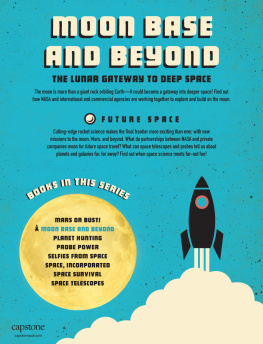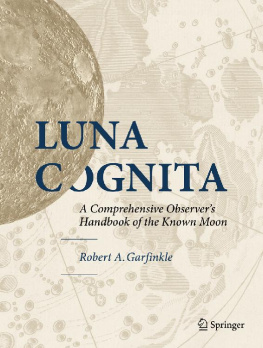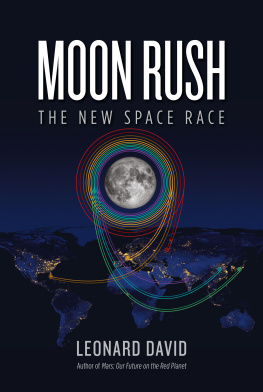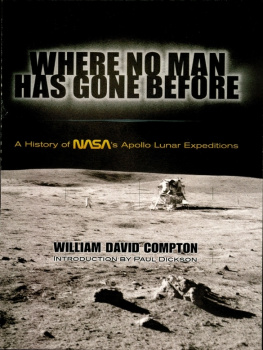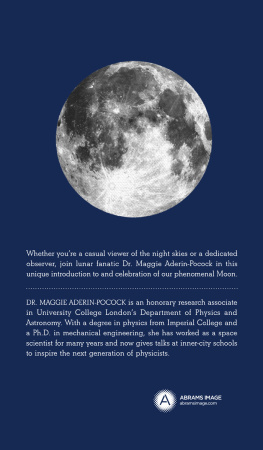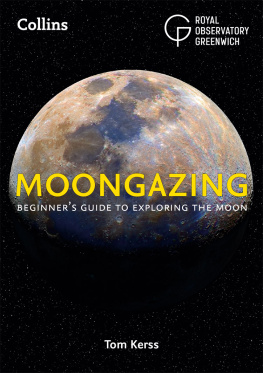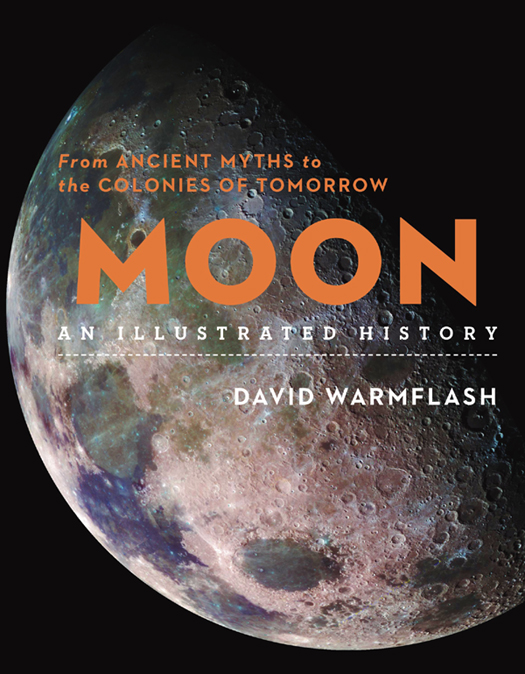ACKNOWLEDGMENTS
Since Sterling Publishing commissioned this book for the fiftieth anniversary of NASAs first human Moon landings celebrated in 2019, acknowledgements must begin with the late US President John F. Kennedy for committing NASA to the ambitious goal on May 25, 1961. Along with recognition of the person at the top, I wish to acknowledge the nearly 400,000 people who worked on Project Apollo within the US government, industry, and academia. Although the names of most of these people are not remembered outside their own families and the places where they worked, the team included a particularly well-known group, namely the Apollo astronauts. Along with those lucky enough to become humanitys first representatives on another celestial body, particular acknowledgement is due to the three astronauts who died training for the mission that became known as Apollo 1: Gus Grissom, Ed White, and Roger Chaffee. In the course of researching and writing this book, I came to appreciate something that astronaut Frank Borman has pointed out in lectures ever since he led the accident investigation team following the Apollo 1 fire of January 1967, namely that the success of all the human Moon missions, occurring from 1968 to 1972, was possible because of the numerous changes that were implemented in the program in response to the Apollo 1 accident.
I am grateful to Sterling Publishing for giving me the opportunity to author this book, and especially for the work that the Sterling team put into the project beginning in the summer of 2017. In particular I thank the two editors who worked directly with me on the manuscript, Meredith Hale and Elysia Liang, as well as Michael Cea, Linda Liang, Christine Huen, Kevin Ullrich, Elizabeth Lindy, and Ellen Day Hudson for their contributions to the project. I am grateful to my literary agent, Regina Brooks of the Serendipity Literary Agency, for all the negotiations, advice, and other work that led to the book and helped it move along, but also for the preceding two years of talking up an idea for a totally different book, which led serendipitously to this book!
Acknowledgments also to historian Richard Carrier, PhD, for providing me some of his insight on science of the Hellenistic and Roman period, and to Michael D. Delp, PhD, of Florida State University for discussing by phone his research and insights regarding space radiation on the cardiovascular system.
About the Author
Dr. David Warmflash is an astrobiologist, space medicine researcher, and science communicator. He received his MD from Tel Aviv Universitys Sackler School of Medicine, and has done post-doctoral work at Brandeis University, the University of Pennsylvania, and the NASA Johnson Space Center (JSC), where he was part of the NASAs first cohort of astrobiology postdoctoral fellows. At JSC, David worked and studied under the late Dr. David S. McKay, who helped found NASAs astro-biology program and decades earlier trained astronauts to conduct lunar field geology.
In the early 2000s, David served as a member of NASAs Jupiter Icy Moons Orbiter Science Definition Team and has collaborated with The Planetary Society on three experiments that have sent microbial samples into space. These included the peace experiment, in which an Israeli and a Palestinian student worked as co-investigators with Dr. Warmflash and other colleagues to study microbial samples that flew on NASAs STS-107. In 2011, David collaborated with The Planetary Society on its efforts to include an astrobiology experiment on Roscosmoss Phobos-Grunt probe, which attempted to make a round-trip to the Martian moon Phobos.
Inspired by Dr. Carl Sagan from childhood into his adult years, David has written numerous articles in scientific journals and popular science publications, including Wired UK, Scientific American, Air and Space, and Leaps Magazine. His pieces cover a range of science topics, from the search for extraterrestrial life and space exploration to genetics, neuroscience, biotechnology, the origins of life, and the history of science. In 2017, David contributed a short essay about the feasibility of human hibernation to George and the Blue Moon by Lucy Hawking and Stephen Hawking. Moon: An Illustrated History is Davids first book.
4.5 Billion Years Ago
FORMATION OF THE MOON
How did Earths moon come into exis-tence, and when did it happen? Lunar samples and lunar probes have given us a precise answer to the when question. Analysis of rock fragments brought from the Moons Fra Mauro highlands by astronauts on Apollo 14 suggests that the Moon is about 4.51 billion years old. The answer to the how question is more complex and always changing.
One idea, proposed by douard Albert Roche in 1873, is that the Earth and Moon formed next to each other in space. The two worlds contain vastly different proportions of iron, however; Earth contains much more iron, most of it concentrated in the planets large, metallic core. Okay, lets try another one: What if the Moon formed far away and was captured later by Earths gravity? Proposed by Thomas Jefferson Jackson See in 1909, the capture hypothesis also has problems, one being that ratios of isotopes of oxygen and certain other elements in the rocks of the two worlds match, almost like fingerprints, as if the Moon were made of the same materials as Earths outer parts. Might Earth thus have flung a chunk of itself into orbit? George Darwin, son of naturalist Charles Darwin, proposed this scenario in 1879, but it too presents problems.
There is also the Giant Impact hypothesis. Proposed by William Hartmann and Donald Davis in 1975, the scenario is that a Mars-sized planet, which scientists call Theianamed for the mother of Selene, goddess of the Moonstruck Earth soon after both planets had differentiated into crust and core. Such a history fit well with findings from Project Apollo that the Moon lacked water and other volatiles (substances that boil easily). It also fit with findings from Apollo and the Lunar Prospector probe that the Moon has at most a very small iron-sulfur core, but the matching of the isotopes between the worlds and issues involving the Earths spin and the Moons orbit have led scientists to propose variations as well as entirely different scenarios. This includes a multiple small-impact hypothesis that was described in 2015 by Oded Aharonson and colleagues of the Weizmann Institute and that took shape in 2017.
SEE ALSO:

Since the 1870s, scientists have proposed several hypotheses to explain the Moons origin.
4.5 Billion Years Ago
MOONEARTH PULLING BEGINS
When the Moon formed, a day on Earth may have taken just four hours, and the Moon was at a fraction of its current distance. It would have looked huge in Earths skies. But Earths spin has slowed, while the Moon has moved farther away.
This cosmic dance comes down to tidal forces. Gravity between two objects decreases with distance, making the Moons gravity stronger on the closer side of Earth and weaker on the opposite side. Earth is thus stretched, slightly in its rocky structure, and substantially in the more flexible oceans. This makes a bulge on the side of the planet facing the Moon, and another bulge on the side facing away from the Moon. Halfway between the two ocean bulges, perpendicular to the EarthMoon axis, the oceans flatten. As Earth spins, this geometry causes two high tides, alternating with two low tides, each day. The difference between high and low tide changes because the Moons distance changes over the course of each orbit, and because the Suns gravity also produces tidal bulges. Solar tides strengthen or weaken the lunar tides, depending on the angle between the Moon, Earth, and Sun. But the lunar tides dominate, because the Sun is much farther away.


